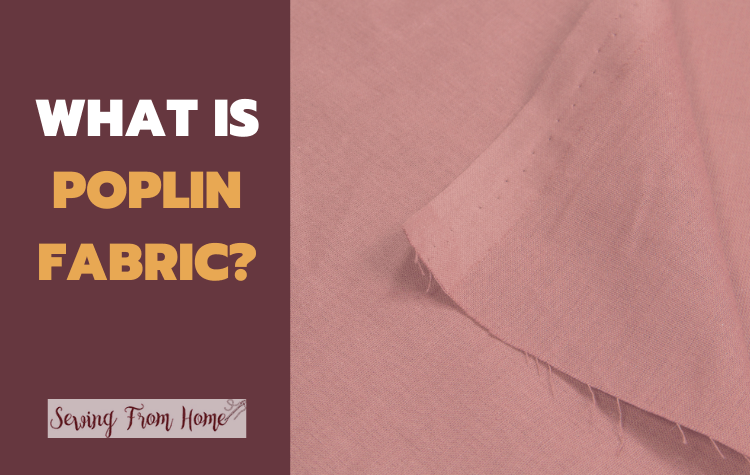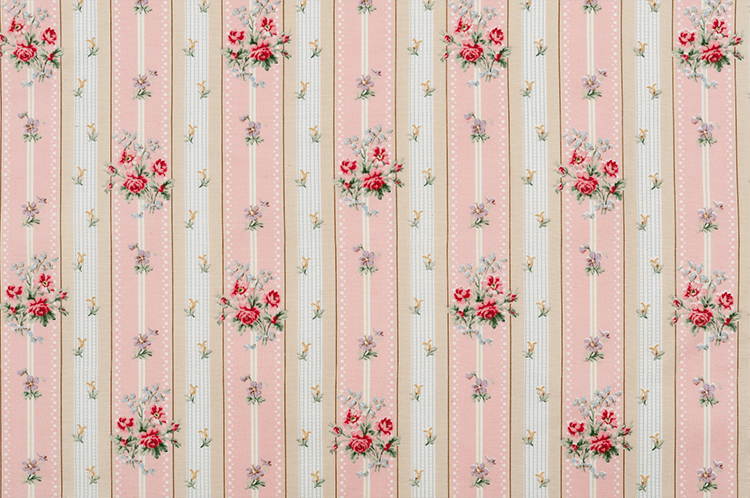Sewing for summer means choosing lightweight, breathable fabrics in fresh colors. It can be hard to choose from the treasure trove of materials available, especially when you have a budget. We’ve all heard of cotton, linen, and even polyester.
But what is poplin fabric?
Poplin is a woven fabric known for its ribbed weave of thinner weft threads and thicker warp threads. The soft cloth can be made from several fibers: silk, wool, rayon, cotton, and polyester. Poplin is a lightweight, lustrous, breathable fabric suitable for summer clothing and home décor items.
Poplin is a standard fabric for summer sewing, as it is soft, light, and cool. But why do stores sell different kinds of poplin? Is cotton poplin the same as rayon poplin?
Let’s explore what makes a fabric poplin and what you can sew with it.
What Is Poplin?

Poplin is an unusual fabric because, unlike cotton or silk, it is defined by how it is woven, not the material it’s made from.
Poplin has a tightly closed weave, with fine, straight grain or warp threads and coarser cross-grain or weft threads. This combination produces a distinctive ribbed texture on the horizontal and a lustrous finish.
When Was Poplin First Made?
Poplin dates back to the fourteenth century and comes from the French word papelaine, referring to the Pope, who was based in the French town of Avignon, where the fabric was made.
At that time, poplin was woven from silk and wool, with the silk forming the fine warp threads and the wool, the stronger weft threads, giving it weight and luster.
Made throughout Europe, poplin was a warm fabric used for winter garments, especially dresses. Despite containing silk, poplin was not considered a particularly luxurious fabric.
Irish poplin became known as “tabinet” and had a watered or moiré finish, used primarily for evening gowns and upholstery.
In the nineteenth century, the British began making poplin with cotton, which had become cheaper than wool and silk. Because the weaving pattern remained, the fabric was still called poplin, but it was more robust than the earlier variety.
While lighter weights of cotton poplin were used for ladies’ dresses, heavier cotton poplin became popular for upholstery and has been used for uniforms since the Second World War.
Poplin was first exported to the United States in the early twentieth century, where it was erroneously called broadcloth.
What Is Poplin Made Of?
Today, poplin is often made from cotton or uses cotton as the weft thread combined with silk, satin, wool, rayon, polyester, or a blend of materials.

Unlike the warm original poplin, today’s version is a much softer, lightweight fabric suitable only for summer wear, but with an underlying crispness and robustness from the cotton. Although it is breathable, poplin does not lock in heat.
Let’s look at a couple of typical varieties of poplin.
Poplin Made From 100% Cotton
To make cotton poplin, two different thread weights of this natural fiber create the ribbed effect.
Cotton poplin combines the strength and durability of the dense poplin weave with all the benefits of cotton. Typically, cotton is soft, cool, and versatile. It absorbs moisture without absorbing odor. The fabric is hypoallergenic, non-static, and breathable, ideal for sensitive and baby skins.
Cotton poplin is a popular fabric for summer-weight shirts, dresses, and trousers, having sheen and drape.
Poplin Made From Polyester Or Polyester Blends
Some types of poplin are made from 100% polyester or polyester blended with cotton. In both cases, the fabric has the qualities of polyester.
Polyester is a synthetic fabric with soft, silky, but robust fibers. It won’t tear, stretch, shrink, or crease like natural fibers.
Pure polyester poplin has a lush texture and drapes well, so it is ideal for blouses and even flags.
Poly-cotton (polyester and cotton blend) poplin is heavier and more durable, so it is often used for uniforms and doctors’ scrubs that remain smart-looking despite frequent washing.
An enormous advantage of poplin made with polyester is that it is budget-friendly but appears more expensive.
Poplin Made From Rayon Blends
Another common material used to produce poplin is rayon (viscose), a semi-synthetic fabric made with cellulose (often from wood or plants).
Rayon has a beautiful drape, almost like silk, but is stronger than cotton and very breathable. This fabric is perfect for blouses, dresses, and nightwear.
What Is Poplin Used For?
Because poplin can be made from different fibers, it is a highly versatile fabric and has many applications, from soft furnishings to evening gowns.
Once you’ve picked up your supplies, here are some of the projects you can use it for:
Poplin Is Used For Clothing
Because of poplin’s durability, easy maintenance, comfort, and appealing texture, poplin is a staple of clothing manufacturers. What items are made from poplin?
- The items most commonly made from poplin are formal and casual shirts, dresses, trousers, and jackets, especially for summer.
- Cotton and rayon poplin are also ideal for luxury pajamas, being light, cool, breathable, absorbent, and non-clingy.
- Poly-cotton poplin is heavier, so it is used for trenchcoats and uniforms.
- To make sportswear, poplin is blended with lycra and spandex for stretch.
Poplin For The Home
Poplin’s versatility extends to home décor, soft furnishings, and other home items. Here are some examples:
- Being soft and breathable, poplin is a good choice for bedding, especially sheets and pillowcases.
- Heavier weights of poplin are used for upholstery, as it is strong and retains its color for years. It is also easy to dye.
- Poplin is useful for light curtains that drape effortlessly.
- Poplin tablecloths are handy for home and commercial use. They are crisp and elegant, but also washable and easy to iron. Poplin doesn’t retain smells, even if food is spilled on it.
How To Sew With Poplin
Your approach to sewing with poplin depends on the kind of poplin you’re using. Here are some guidelines for sewing with different varieties of poplin.
First, consider which sewing machine needle and thread you will use.
- For cotton poplin, use a universal or standard-sized needle (80/12) and all-purpose thread.
- Use a smaller needle (70/10) and polyester thread for polyester poplin. Take care when pinning polyester poplin, as the pins can leave visible holes.
Next, consider the sewing machine foot.
- Silk and rayon poplin can be slippery and tricky to work with. You need a walking foot or even-feed foot with built-in feed dogs to hold the two layers of fabric level and move them simultaneously when sewing. Use fabric weights, if necessary.
- Polyester and cotton poplin are easier to handle, so you can use a standard foot.
In terms of patterns, think about the following.
- Avoid sewing garments that need structured detail or tailoring, such as jeans or cargo pants, as most poplin is not heavy or structured enough.
- Poplin’s ability to avoid creasing means it is inappropriate for pintucks or pleating.
- Poplin does not stretch or have any “give,” so allow extra fabric for easy wearing.
- Lightweight poplin is delicate, so use rolled hems that are easier to fold over and stitch.
- Poplin lends itself to ruffles and frills.
Here’s how to maintain the poplin items you’ve sewn.
- Poplin does not require dry-cleaning.
- It is usually machine-washable, but take care not to wash it on hot – 100% cotton poplin may shrink.
- Most poplin is crease-resistant, needing a light steam or tumble dry to smooth out any wrinkles. Do not iron polyester poplin as it will melt.
- Poplin does not stain easily.
Are Poplin, Twill, And Broadcloth The Same Fabric?
Although some use the terms interchangeably, poplin, twill, and broadcloth are not the same fabric. Let’s look at the similarities and differences between them.
Poplin vs Twill
Twill and poplin are similar in that they are both woven fabrics that can be made from different fibers.
Poplin’s characteristic is being woven with a fine warp thread and thicker weft threat, creating a ribbed effect, and making it softer than twill. It is light, drapey, and best for warmer weather, as it is wrinkle-free and moisture-wicking.
Twill’s weave creates a diagonal ribbed effect since each warp thread is woven under and over two weft threads. This results in a staggered weave, rather like a herringbone pattern.
Because of how it is woven, twill is heavy, durable, and dirt and water-resistant. Denim is a typical twill and is ideal for workwear.
Twill is suitable for winter wear, as it is densely woven, structurally rigid, and warmer than poplin. It is less breathable than poplin.
Poplin vs Broadcloth
Because of a naming error in the 1920s, poplin has always been confused with broadcloth. It is unsurprising, though, as the two fabrics are similar.
Both fabrics are characterized by their weave and sheen and can be made from cotton or poly-cotton blends. Either material is suitable for shirts, blouses, skirts, and trousers.
Broadcloth is not woven like poplin, which has a thinner weft and thicker warp thread. Instead, both yarns used to weave broadcloth are much thicker and more robust, creating a sturdier, medium-weight fabric.
Because of the differences in weave, broadcloth and poplin aren’t interchangeable. Being heavier, broadcloth is suitable for winter wear.
Our Verdict On Using Poplin Fabrics
Poplin is a textured, woven fabric made from silk, wool, cotton, rayon, or polyester. It is characterized by its ribbed and lustrous appearance, as well as its soft drape, breathability, weight, and coolness.
Poplin is an excellent choice for sewing summery items.
